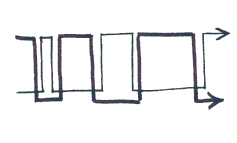
A). Carry out the operation continuously ((all object parts should work all the time with full load achieving synchronization of cumulative actions);
B). Eliminate idling and intermediates;
C). Continuity is often achieved by going to rotation (see Method 9 [14]).

The opposite:
A). Divide the continuous action into intervals with the intermediate useful result;
B). Do not plan to unify two processes into one continuous, if at the point of connection there arise difficulties which are hard to handle.
Synthesis:
A). Discontinue processes. The result of a first process must match the input of the second process, so that the chain Process1->intermediate->Process2 could run continuously. See the Method of Mediator.
* * *
Example. At Mogilev chemical plant in 1980-s the german production of fibers followed the process of producing the plastic granules out of continuously formed plastic sticks extruded out of hot plastic mass. Then the granules where stored, sold to third parties, or transported to another plant where they were melted again, and filaments were extruded from it. The russian designers wanted to improve it. They designed "continuous process" (it was called like that: непрерывка). The filaments were extruded out of the hot plastic mass bypassing the granules stage. That often led to disaster very difficult to handle: every subtle variation or fatality of chemical process immediately affected the extrusion stage clogging the extrusion equipment and the equipment before it (as if a wave of fatalities reflected back from the extrusion part), the mass than overburned and tons of plastic along with filaments where spoiled. Then all equipment needed to be cleaned and fixed.
The difference with Method 15 [19] anti-principle "Continuous Action" is that in the 15, the action is related to the same object. In here, "Continuity of Useful Actions" it refers to multitude of actions and objects.
This is the Method 16 [20] | Index